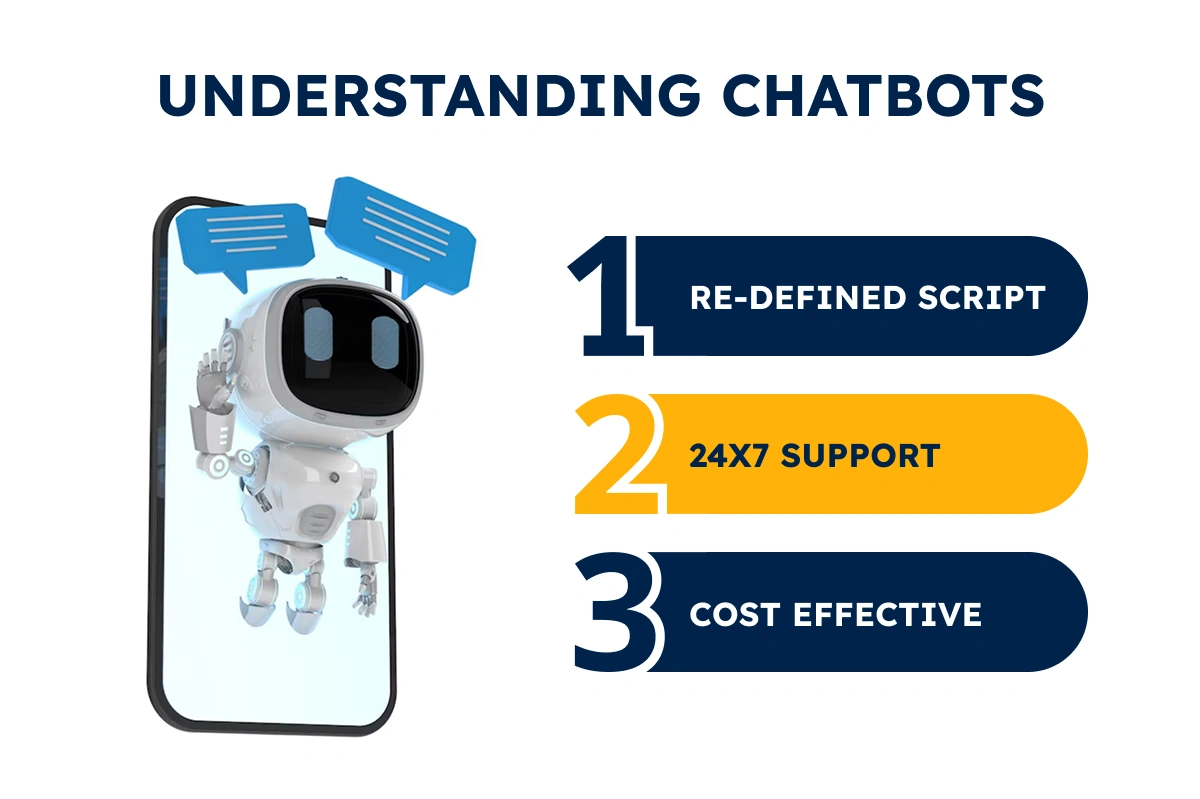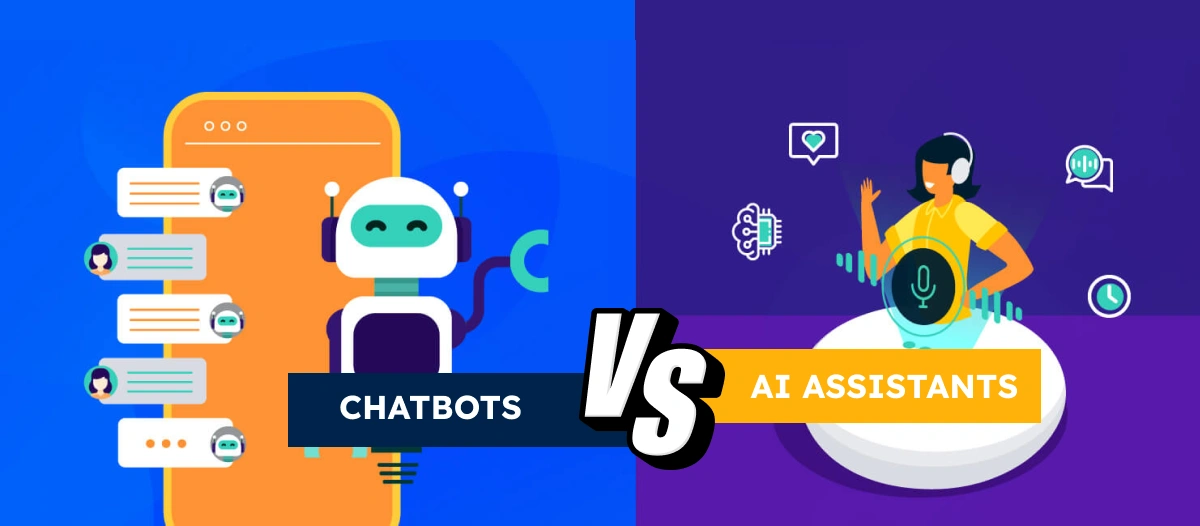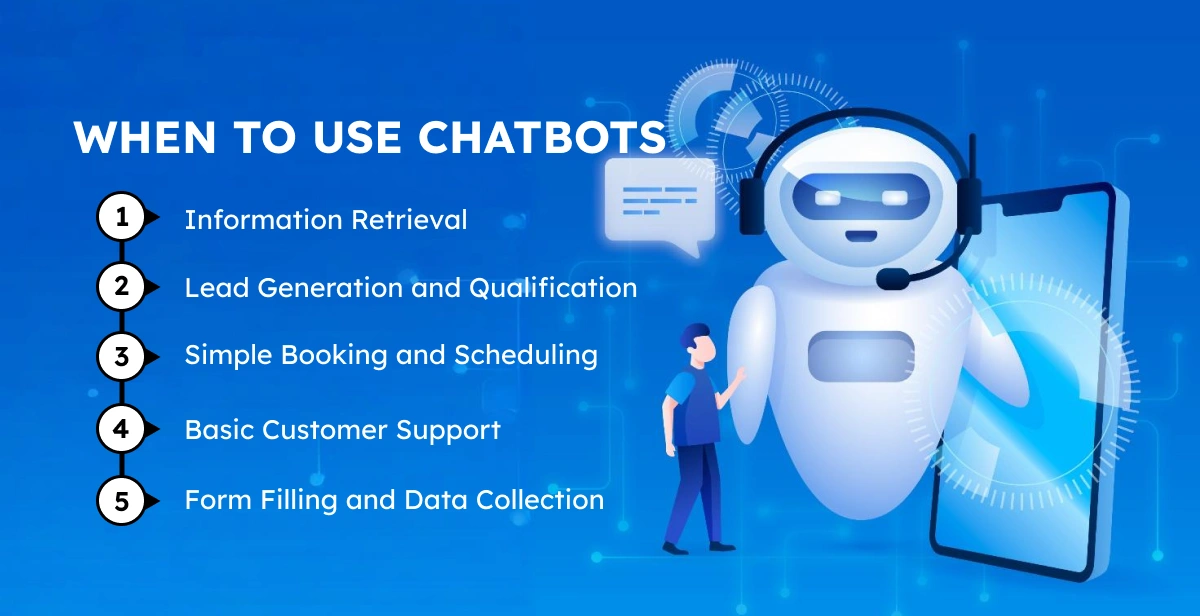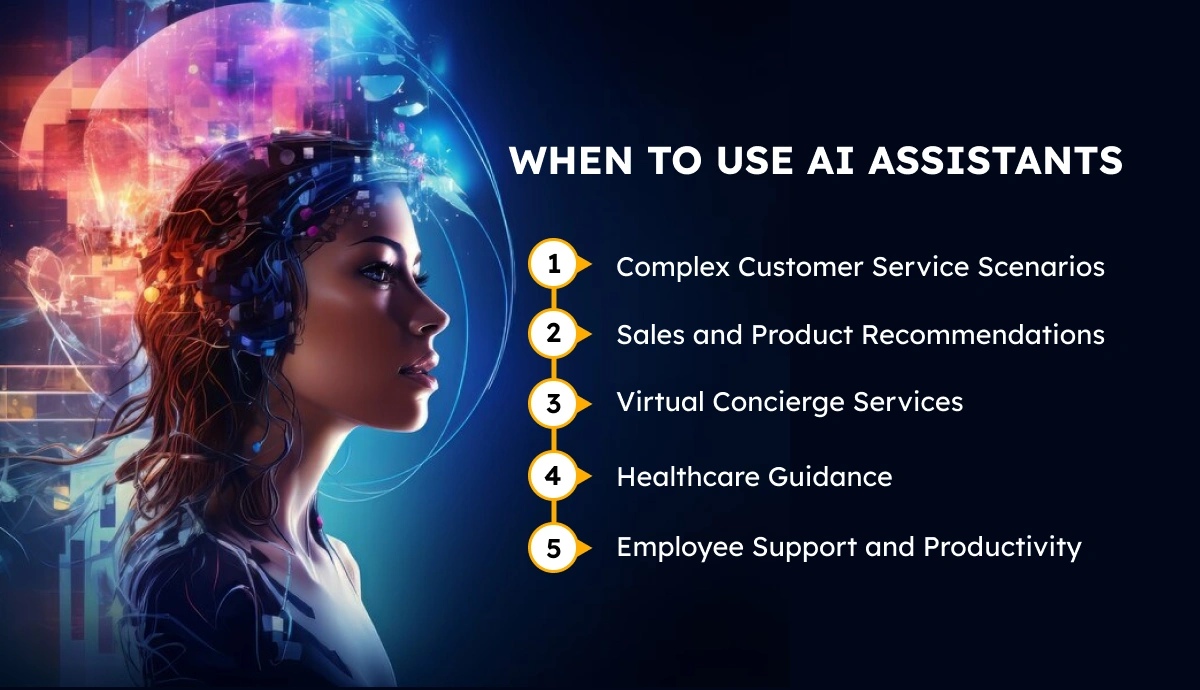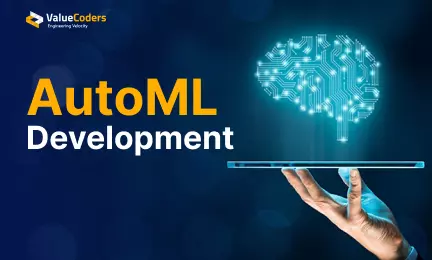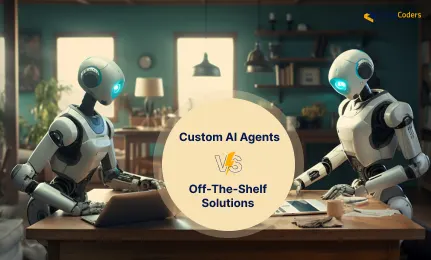Looking to automate support, cut costs, or improve user experience?
You’ve likely come across two popular solutions: chatbots and AI assistants. While they may sound similar, they offer very different capabilities.
Chatbots are rule-based. AI assistants are intelligent, adaptive, and built for the future.
The tool you choose will directly affect:
- Customer experience
- Team efficiency
- Operational costs
- Scalability of support
This guide breaks it all down: features, benefits, limitations, use cases, and what to consider before implementation.
Let’s find out which solution aligns best with your business goals.
Understanding the Fundamentals: Chatbots vs. AI Assistants
AI and Chatbots for business have evolved into essential tools. Each serves different roles depending on your goals, complexity of interactions, and long-term vision.
What Are Chatbots?
Chatbots are rule-based systems designed to handle repetitive, predictable tasks such as answering:
- FAQs
- Order tracking
- Account lookups
- Simple troubleshooting
They operate through predefined decision trees and are ideal for delivering consistent responses to structured queries.
Why businesses use basic chatbots:
- Cost-effective to deploy
- Simple to manage with minimal training
- Reliable for repetitive queries
- Quick to launch and scale
If you want to deploy your own chatbot, our Chatbot Development Services offer plug-and-play solutions and custom integrations.
Our AI consultation services help you decide when to choose a chatbot and when to invest in AI.
What Are AI Assistants?
AI assistants or virtual assistants are like the upgraded version of chatbots. It’s smarter and better at holding a conversation that actually feels human.
Unlike chatbots, they use natural language processing (NLP) and machine learning (ML) to understand context, intent, and even emotion. So when a customer asks for something unexpected or complex, these assistants.
They can:
- Understand open-ended or vague questions
- Remember what was said earlier in the conversation
- Recognize tone and sentiment
- Offer suggestions or next steps based on user behavior and past data
Why businesses are turning to AI assistants:
- Handle complex, multi-step queries
- Deliver more personalized customer experiences
- Reduce reliance on human agents for advanced support
- Scale smarter as customer expectations grow
Also read: AI-Powered Future: Revolutionizing Businesses With Tools Like ChatGPT
Key Differences Between Chatbots and AI Assistants
Chatbots and virtual assistants differ significantly in their functions, capabilities, and long-term value. Understanding these differences will help you make the right choice that aligns perfectly with your business goals and customer expectations.
1. Intelligence Level
Chatbots
Operate using predefined rules and structured decision trees. These systems respond only to specific triggers or keywords and can’t understand queries that deviate from expected formats.
AI Assistants
Advanced AI technologies, including machine learning and natural language processing, enable AI assistants to accurately interpret user intent from complex or ambiguous messages. These systems continuously improve through interaction and adapt their responses based on context and historical data.
For simple, routine automation, building an AI chatbot is a cost-effective. However, AI assistants provide superior intelligence and adaptability for businesses requiring sophisticated, evolving customer interactions.
2. Conversational Capability
Chatbots
Engage in scripted or rule-based conversations. They typically follow a decision-tree format and are only effective in situations where the questions and answers are predictable.
AI Assistants
Deliver context-aware, natural conversations by remembering conversation history, asking clarifying questions, and adapting to user mood and tone. Provide smoother, more personalized interactions that build better customer relationships and increase engagement.
AI assistants offer smoother, more personalized text that builds better customer relationships and drives higher engagement.
Choosing wrong can cost more. Make the right call with our experts.
3. Task Complexity
Chatbots
They are designed for simple, repetitive tasks like answering FAQs, guiding users to specific pages, or collecting form data. They’re great for quick support but lack depth.
AI Assistants
Can manage complex, multi-step workflows, including booking services, navigating systems, offering product recommendations, and even processing transactions.
If your use case requires multitasking, contextual responses, or logic-based decision-making, an AI service company can build solutions tailored to these demands.
4. Personalization
Chatbots
Provide generic, one-size-fits-all responses with limited ability to tailor conversations based on the user’s identity or history.
AI Assistants
Offer hyper-personalized experiences by analyzing user data, browsing behavior, past interactions, and preferences. They can suggest relevant products, preemptively answer follow-up questions, and even predict needs.
Personalized conversations lead to stronger customer retention, improved satisfaction, and more conversions.
Also read: Grok AI: Here’s All About Elon Musk’s Chatbot
5. Development Complexity
Chatbots
They are quick to develop and cost-effective, making them ideal for businesses that need a fast digital assistant with low upfront investment. No AI training is needed.
AI Assistants
Requires greater time, resources, and expertise to build and maintain. They need AI/ML training data, NLP tuning, cloud infrastructure, and ongoing monitoring to deliver consistent performance.
While AI assistants take more effort to implement, they offer far greater returns in terms of capability, automation, and long-term scalability.
The debate, chatbots vs AI assistants, reveals significant differences in capability. Choose one that fits your business requirements and satisfies the job task. In short, if you’re less on time or budget, a team of experienced Chatbot developers in India can help you deploy fast, scalable solutions without compromising quality.
We help you build AI-driven chatbots personalized to your audience.
Business Applications and Use Cases: When to Deploy Chatbots vs. AI Assistants
Choosing between a chatbot and an AI assistant depends on how complex your customer interactions are.
Below, we outline when to use customer support chatbots and when to deploy AI assistant services. For accurate implementation, expert AI engineers can help assess your needs and build the right solution.
When Chatbots Make the Most Sense
1. Information Retrieval
Chatbots excel at delivering standardized knowledge instantly and consistently.
- Answer repetitive questions (hours, pricing, policies)
- Provide consistent information 24/7
- Free human staff for complex tasks
- Deliver immediate responses regardless of time
2. Lead Generation and Qualification
Transform passive visitors into qualified prospects with automated engagement.
- Engage website visitors proactively
- Collect qualification data automatically
- Handoff promising leads to the sales team
- Create a frictionless prospect experience
3. Simple Booking and Scheduling
Eliminate scheduling friction with automated appointment management.
- Display available appointment slots instantly
- Confirm bookings automatically
- Send appointment reminders
- Eliminate waiting for business hours
4. Basic Customer Support
Resolve predictable support scenarios without human delay.
- Guide through standard troubleshooting steps
- Process simple returns or exchanges
- Explain common product features
- Provide immediate resolution for straightforward issues
5. Form Filling and Data Collection
Boost completion rates by replacing static forms with conversational interactions.
- Replace intimidating forms with conversational interfaces
- Gather information through natural dialogue
- Increase form completion rates
- Collect higher-quality customer data
Also read: 70+ Artificial Intelligence (AI) Startup Ideas For 2025
When AI Assistants Deliver Superior Results
1. Complex Customer Service Scenarios
AI excels at managing intricate customer service across multiple interactions.
- Connect dots across multiple interactions to maintain context
- Understand underlying customer sentiment and emotional nuances
- Handle unexpected conversational turns with adaptive responses
- Transform frustrating experiences into relationship-building opportunities
2. Sales and Product Recommendations
Sophisticated virtual shopping consultants, driving revenue through intelligent suggestions.
- Function as sophisticated virtual shopping consultants
- Analyze purchase history and behavioral patterns for relevance
- Deliver hyper-personalized product suggestions
- Boost conversion rates and average order values measurably
3. Virtual Concierge Services
It anticipates needs and maintains personal preference profiles.
- Anticipate customer needs before they’re explicitly stated
- Remember detailed personal preferences across interactions
- Orchestrate complex arrangements in hospitality and travel
- Scale white-glove service experiences cost-effectively
4. Healthcare Guidance
Provides contextualized health support through analysis of symptoms and patient history.
- Process complex symptom descriptions with contextual understanding
- Consider medication histories and lifestyle factors holistically
- Provide personalized health management recommendations
- Bridge the support gaps between professional healthcare appointments
5. Employee Support and Productivity
Improve workplace efficiency by automating complex workflows.
- Navigate complex internal systems and knowledge bases
- Synthesize information across previously siloed databases
- Automate multi-step workflows that require manual handling
- Improve resource utilization throughout organizations
Choosing the right automation strategy can double your returns.
Conclusion
When deciding between chatbots and AI assistants, it comes down to your specific needs. The entire article has clearly mentioned the use of AI Chatbots and AI assistance, choose the right solution that addresses your business needs.
To develop a custom solution, choose an AI development company like ValueCoders that understands your requirements and aligns the best team for building the AI solution.
Our team excels in delivering high-quality work and tangible business results. Being a renowned AI solution company
Let’s build your smarter support system today. Contact us now!


